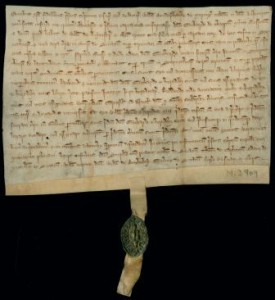December 20, 2011, by C Fawcett
A clove of gillyflower at Christmas
A curious reference to Christmas Day (natale Domini) appears in this medieval deed, which records a land transaction made about 730 years ago. The parties agree to an annual rent charge of a clove of gillyflower ‘unum clavum Gariofilum’ payable at Christmas. A gillyflower is a carnation with the clove being the dried flower buds, and many other examples can be found of its use in this way, as a nominal rent.
Prior to 1290 when a property was conveyed such nominal rents are often specified, as a way of the seller maintaining feudal rights in the land. The best known of these nominal rent charges was a peppercorn, giving rise to the name ‘peppercorn rent’ for all nominal payments. There are over 100 documents within local family archives held by the University in which a peppercorn rent is stipulated. Other common forms of nominal payments are a silver penny, a red rose or a flowering rose.
Such documents were created for legal purposes but today can be of interest to a wide variety of different researchers. For example, academics can analyse networks of influence or identify topographical boundaries revealing land use. Local historians can trace the development of communities and family historians can find their ancestors appearing in the deeds as purchasers or sellers of property, heirs, tenants or witnesses. Despite these rewards, deeds are one of the most underused resources in archival collections, as their Latin language and legal terminology put off many users. Detailed catalogues help to make their contents more accessible and guides are available to explain the features of deeds and help researchers to identify different kinds of historic property transactions.
This deed from the Middleton Collection records the gift of land in Sternthorp and Sutton upon Trent. It provides information about the original owner William Bondeschathe, his daughter Alice and her husband William de Leicester, and their sale of the toft and land to Lord Guiscard de Charron.
Medieval documents and books in the University’s collections have featured in displays and research projects. An introduction to the resources and their characteristics helps new researchers to locate them and use them.
No comments yet, fill out a comment to be the first


Leave a Reply